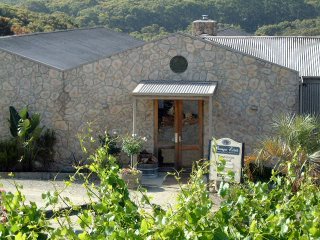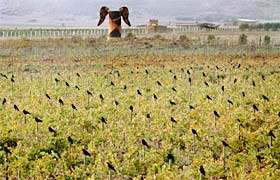
The wineries on the Mornington Peninsula close at 5 PM and as we paid for our non-wine purchase at Port Phillip Estate that witching hour was fast approaching. There was only one thing to be done, we would have to ask for directions to the next winery, Paringa Estate. This young winery was established by the McCall’s in 1985 with the first vintage made in 1988. Their wines are made from both Estate and Mornington Peninsula fruit by Lindsay McCall. Fortunately Paringa Estate, we were informed, was just down the road. “On the left. Just down the road.“ I made sure to ask twice. And he was right, well almost, we had two left turns to make but it was close enough that we pulled into an empty parking lot at five minutes to five. Still this was going to be close! No time to visit any restrooms.
We need not have worried. Although the tasting bar was vacant, the restaurant still had tables occupied with diners admiring the view and in a couple of cases each other. And even though all the staff were in cleanup mode no one seemed to be a hurry, especially the guy behind the wine bar. Even so we thought that maybe we shouldn’t overstay our welcome, so we’d just do the reds. But as I perused the line-up of bottles it was obvious that the Reserve level wines were no where to be seen. This was unfortunate because the 2003 Reserve Shiraz was only the second release of this special barrel selection of Shiraz, and I’d been looking forward to tasting it. I’d even ignored the fact that one email to Paringa had been bounced back and a second try had failed to raise a reply. The wine might just be worth being ignored. But I guess I was going to have to put Paringa Estate down as another winery that pretty much ignores the enthusiastic amateur. Still I could at least take my time getting notes on the reds that were on offer.
Writing tasting notes can have interesting effects on the people around you. In this case I didn’t even need to ask if it might be possible to taste the Reserve wines. As soon as I had finished jotting down notes on the Estate level wine and poured the rest of my glass into the spit bucket the guy behind the bar reached to his right and brought the hidden bottle into view, gave me a pour and then left the bottle so I could make notes from the label. OK, so some wineries only like to pour their best for folks they think are serious about wine. Problem is that one of the best ways to get serious about wine is to taste the best stuff you can get your hands on and one of the least expensive ways to do that is to taste at wineries.
Long story short I’m all for wineries that let you taste the expensive stuff, even if you have to pay a few dollars to do so. Torbreck Vintners in the Barossa in a classic example. If Paringa Estate wants to hide their best wines from all but the most serious then they don't make make my list of wine taster friendly wineries. Which is unfortunate because they make some nice wines like the 2004 Paringa Peninsula Pinot Noir (screw cap) ($25AUD). Light cherry red in color with aromas of ripe cherries and a little nail polish. Soft and supple in the mouth with excellent carry of flavors onto the palate. A very pleasant wine. 2, 2, 3.8, 10.0 = 17.8/20, 89/100. 14.5% alcohol. The 2003 Paringa Estate Pinot Noir ($55AUD) was cherry red and very closed giving up only faint spices. But the quality shows in the excellent mouth feel, impeccable balance, and finely boned structure. 2, 2, 3.6, 10.3 = 17.9/20, 90/100. 13.7% alcohol. Its expensive big brother, the 2004 Paringa Reserve Pinot Noir ($90AUD) also cherry red is another shy wine with soft floral and spicy notes over smoky oak. Very well structured with excellent balance and great varietal definition. 2, 2, 3.9, 10.3 = 18.2/20, 91/100. 14.9% alcohol.
The three Shiraz wines seemed much riper than any other Shiraz tasted during our day on the peninsula. The 2003 Paringa Peninsula Shiraz (screw cap) ($25AUD) was cherry red with pink edge in color and gave aromas of pepper and rich tomato paste. Medium to full bodied it was rich and ripe with blackberry and pepper on the palate. Nicely structured with firm tannins and pleasant length to the finish. Surely the best value. 2, 2, 4.0, 10.1 = 18.1/20, 90/100. 13.4% alcohol. Somewhat unusual for cool climate was the 2003 Paringa Estate Shiraz ($45AUD) (40% New Fench Troncais Oak). Also cherry red with pink edge it gave a hint of chocolate over ripe jammy flavors. Medium weight, with the juicy acidity just a touch overdone, it was not as structurally sound as the other wines. The finish was supported by firm tannins. 2, 2, 4.0, 9.8 = 17.8/20, 89/100. 13.7% alcohol. The 2003 Paringa Reserve Shiraz ($70AUD) (100% New French Troncais Oak) was cherry red with red edge. The aromas are of red and black fruits, and again light chocolate. Nicely balanced, with the flavors carrying well onto the palate and supported by firm tannins it finishes with a slight bitterness. 2, 2, 4.1, 9.9 = 18/20, 90/100. 13.7% alcohol.
Chocolate in cool climate Shiraz? I cannot tell a lie, that is what I smelt in the Estate and Reserve Shiraz wines. Well 2003 did have extremely warm and dry conditions that would have allowed Shiraz to achieve more ripeness and concentration. Before we left I snapped up a bottle of the Estate Shiraz to drink later just to make sure.




